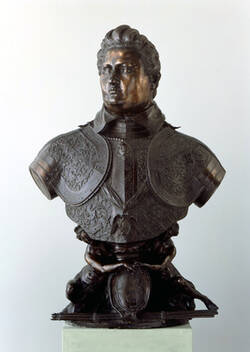This brilliant portrait of a ruler was commissioned by Rudolf II (his portrait medallion hangs on the ribbon above his chest) as a gift for Christian II and is a counterpart to the famous bust of the emperor also created by de Vries (Kunsthistorisches Museum, Vienna). Alluding to the desired alliance, the two female supporting figures join hands in unison, while in front of them lies a bundle of arrows as a symbol of their common strength, which, unlike a single arrow, cannot be broken.
Further Media




The portrait bust is full of political allusions. Over the magnificently decorated armour, a medallion bearing a likeness of Rudolf is held by a Habsburg double-headed eagle – an unequivocal reference to Rudolf’s hope for Christian II’s loyalty. The two female figures bearing the bust on their shoulders have joined hands over the arms of Saxony – a sign of their bonds and friendship. The bundle of arrows in front symbolises unity. The message: while one single arrow can be broken, an entire bundle cannot.
At the base of the neck of the armour, de Vries has set two heads also alluding to a ruler’s virtues of wisdom and strength. The head of the Gorgon on the front with its hair of poisonous serpents references the shield of Minerva, the goddess of wisdom. At the back, a lion’s head stands for Hercules, the epitome of strength.
Yet despite Rudolf courting Christian’s friendship, he was still emphatic about the difference in rank between a Holy Roman Emperor and an Elector. And de Vries found an ingenious solution to that status issue. While Rudolf’s portrait bust shows the entire breastplate down to the waist, Christian’s torso is cut off in the middle, so an Elector is significantly shorter than an Emperor.
Rudolf II, Holy Roman Emperor, was a great art lover and collector. Originally, he hoped to attract the sculptor Giambologna to his court. When that proved impossible, Rudolf appointed Giambologna’s most talented pupil – Adriaen de Vries. And, as they say today, de Vries was a good catch. Born in the Netherlands, de Vries was an excellent portraitist and nothing short of virtuoso in his bronze sculptural works. His portrait bust of Christian II, Elector of Saxony, is a masterpiece and much impressed his contemporaries. De Vries also found an unusual solution for a difficult question: What should Christian’s portrait bust stand on? In antiquity, the transition between figure and base was often hidden under some draped material. But de Vries opted to place Christian’s powerful body on the shoulders of two female figures.
A renowned brass founder was responsible for casting the bust. Afterwards de Vries carried out the task of cold-working the statue himself. In this very intensive step of the procedure, the pouring and air channels had to be removed, the holes filled, and the surfaces treated and smoothed. De Vries’s skills here were outstanding. Christian’s face and the skin of the two nude women glimmer softly, while the texture of the Elector’s wavy hair contrasts with the metal of the armour and the material of his collar.
The technique of bronze casting is over 2000 years old. The process, which is quite complex, begins with the artist modelling a figure from wax. The wax figure is then coated with clay and allowed to dry. When the mould is heated, the outer layers of clay are baked and the soft wax inside melts leaving the mould to cast the bronze.
However, given the risk of damage when removing an entire mould, a figure is often not cast as one unit, but in individual pieces. In the next stage, enough molten wax is poured into the moulds to form an even wax layer inside. This needs to be as smooth as possible since it later corresponds exactly to the figure’s ‘bronze skin’. The rest of the hollow mould is then filled with a mix of wet clay and sand. When this core has hardened, the individual pieces covered in wax can be removed from their moulds and joined together to form the entire figure. The pieces are joined with core pins and the wax edges smoothed and joined with a hot knife. At this point, the wax intermodel, as it is called, is fully assembled. In the next stage, wax rods are added to the intermodel to provide channels for the bronze during the casting process.
Then the outer mould is built up. To ensure every detail is reproduced, the clay coating over the figure is added layer for layer. After it has been fired, the massive form is inverted so the melted wax can flow out. As the wax rods, known as sprues, melt and form hollow channels, they provide the route to pour in the hot molten bronze into the mould, and at the same time let the air escape. After the metal cools, the sprues are sawn or chiselled off, the holes filled and, in the last step, the surface cleaned, smoothed and polished.
- Location & Dating
- 1603
- Material & Technique
- Bronze
- Dimenions
- H: 96 cm, B: 66 cm, T: 41 cm
- Museum
- Skulpturensammlung
- Inventory number
- H4 001 / 004